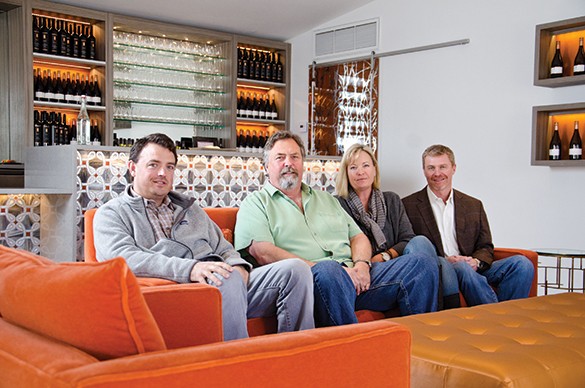Wineries spar over marketing district
IN THIS ARTICLE
- Agribusiness Topic
- Tom Bronzini Author
By Tom Bronzini Saturday, October 3rd, 2020
A two-year push by the Santa Barbara County Vintners Association to establish the world’s first wine business improvement district is running into opposition from a recently formed coalition of wineries seeking a compromise more acceptable to many smaller producers.
The Santa Barbara County Wine Country Coalition sent an email Sept. 25 to 300 wineries in the county detailing its opposition to the improvement district proposal. As of press time it had lined up 67 supporters.
“We are not only opposing the BID, but we want to offer something constructive to basically come together and offer some alternatives,” said David deLaski of Solminer Wine Co., one of the anti-BID coalition’s organizers.
A business improvement district, or BID, levies a fee or tax on its members to pay for shared infrastructure, marketing or other improvements. It typically covers a geographic area, such as a downtown business district, but BIDs can also be specific to industries such as tourism. The Santa Barbara County Vintners Association says theirs would be the first wine BID in the world, though there are three other wine regions also pursuing BIDs.
If approved—by the Santa Barbara County Board of Supervisors and a vote of wineries weighted by direct-to-consumer revenue—a BID called the Santa Barbara County Wine Preserve would receive funds from a 1 percent fee on all direct-to-consumer sales by county wineries to California customers. That would raise $1 million a year to promote the region’s wine industry, according to the Vintners Association. The fee would apply to all sales made directly to California customers, including wine purchases, club shipments in the state and charges for tastings, food, tours, events and merchandise.
The association began formulating the BID in 2018 as an answer to its longstanding problem of lagging behind other wine regions in marketing. It said its operating budget for 2017 was $552,000, compared to $1.5 million for Paso Robles, $1.6 million for Sonoma and a whopping $7.2 million for Napa Valley.
Prominent members of the wine community have lined up on both sides of the proposal. Supporters include longtime winemaker and restaurateur Doug Margerum; Tim Snider, president of Fess Parker and Epiphany wines; and the Miller family, owners of Bien Nacido Vineyards and Miller Family Wine Co. Those opposed include longtime vintners Steve Beckman, Fred Brander, Rick Longoria and Kate Griffith.

One of the Wine Country Coalition’s objections is that the proposal would be decided by a weighted vote based on direct-to-consumer revenues of each winery in 2019. Larger wineries with more sales would have a greater say.
Out of more than 300 wineries in Santa Barbara County, 80 percent of sales are made by 80 wineries, the Vintners Association has determined. The anti-BID coalition says a handful of top-grossing wineries could constitute a 51 percent majority, and all wineries would then have to collect the fee.
Alison Laslett, CEO of Santa Barbara Vintners, said in a phone interview that California law requires a weighted vote to establish a BID, allowing larger contributors to have a greater say in its formation, she said.
“We did actually go to investigate the law and see if it could be interpreted differently, something along the lines of one winery, one vote,” but that was not allowed, Laslett said.
Laslett is convinced the BID has majority support from wineries. The Vintners Association’s latest straw poll showed 60 percent in favor when weighted by the same revenue formula that would be used in the final vote. If the BID is approved, all county wineries would become de facto members of the Santa Barbara County Wine Preserve and have an equal vote in its governance.
Another objection is that small wineries whose consumer sales make up a majority of their business would pay a higher proportion in fees than large wineries whose gross sales include income from wholesale business, vineyards, hotels and custom crush facilities. Laslett said she understands the concerns, but is confident the fee would not hurt business. Tourism revenues in various Santa Barbara County communities that have adopted tourism BIDs have gone up even with the new fees, she said.
Another concern is that cities in Santa Barbara County would have to opt in to the BID. The coalition email says the latest straw poll of wineries shows that Lompoc would likely opt out, and the city and most of the Sta. Rita Hills viticulture area would not be promoted by the BID.
Leaders of the anti-BID coalition met Sept. 28 and talked about restructuring the Vintners Association with a more broad-based board representing large and small wineries, every viticulture area and every city in the region. DeLaski said the group discussed other fundraising options, including a grape commission that would charge a fee to everyone buying grapes. He would support that, he said, even though it’s not voluntary, because it is something everybody would pay on an equal basis. The Vintners Association said in its news release that it is considering a grape commission, but it would take longer to create and would be less efficient than a BID.
The final BID plan is under review by the county of Santa Barbara and the Vinters Association’s legal team. Laslett said she anticipates circulating petitions during October and early November. If the weighted votes total more than 50 percent approval, the BID would next go to the Board of Supervisors for public hearings and a vote. If it advances, city councils in the county would vote on opting in for their cities.
NOTE: An earlier version of this article contained an error regarding the Vintners Association straw poll of wineries. The poll indicated that 60 percent of the votes, when weighted by revenue, would be in favor of the BID, not 60 percent of the wineries.
Related Articles
 Thursday, June 3rd, 2021
Thursday, June 3rd, 2021
Register now for our Best Places to Work awards reception and panel discussion
 Wednesday, March 3rd, 2021
Wednesday, March 3rd, 2021









